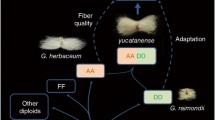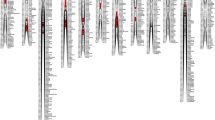Abstract
To increase the numbers of microsatellites available for use in constructing a genetic map, and facilitate the use of functional genomics to elucidate fiber development and breeding in cotton, we sampled microsatellite sequences from expressed sequence tags (ESTs) transcribed during fiber elongation in the A-genome species Gossypium arboreum to evaluate their frequency of occurrence, level of polymorphism and distribution in the At and Dt subgenomes of tetraploid cotton. From among ESTs derived from G. arboreum fibers at 7–10 days post anthesis (dpa), 931 ESTs were found to contain simple sequence repeats (SSRs); 544 (58.4%) EST-SSR primer pairs were developed, and 468 (86%) amplified PCR products from allotetraploid cotton ( G. hirsutum cv. TM-1 and G. barbadense cv. Hai7124). However, only 99 (18.2%) of these were found to be polymorphic and segregating in our interspecific BC1 mapping population [(TM-1×Hai7124)×TM-1]. In these amplified and informative EST-SSRs, hexa- and tri-nucleotide repeat motifs were the most frequent, representing 40.1 and 30%, respectively, of the total. A total of 111 loci detected with these 99 EST-SSRs were integrated into our backbone map including 511 SSR loci. The distribution of the EST-SSRs appeared to be non-random, since 72 loci were anchored to the At and 37 to the Dt subgenome of allotetraploid cotton based on linkage tests. Interestingly, out of the 10 pairs of duplicate loci amplified, seven were mapped to the corresponding homeologous linkage groups and/or chromosomes. BLASTX analysis revealed that 69 of the 99 ESTs showed significant similarities to known genes. Some genes important for fiber development, such as sucrose synthase, were mapped to corresponding chromosomes. These EST-SSRs provide structural and functional genomic information that will be useful for understanding cotton fiber development.





Similar content being viewed by others
References
Ayers NM, McClung AM, Larkin PD, Bligh HFJ, Jones CA, Park WD (1997) Microsatellite and single nucleotide polymorphism differentiate apparent amylose classes in an extended pedigree of US rice germplasm. Theor Appl Genet 94:773–781
Brubaker CL, Bourland FM, Wendel JF (1992) The origin and domestication of cotton. In: Smith CW, Cothren JT (eds) Cotton. Wiley, New York, pp 3–31
Brubaker CL, Paterson AH, Wendel JF (1999) Comparative genetic mapping of allotetraploid cotton and its diploid progenitors. Genome 42:184–203
Crane CF, Price HJ, Stelly DM, Czeschin DJ Jr (1994) Identification of a homeologous chromosome pair by in situ DNA hybridization to ribosomal RNA loci in meiotic chromosomes of cotton ( Gossypium hirsutum). Genome 36:1015-1022
Decroocq V, Fave MG, Hagen L, Bordenave L, Decroocq S (2003) Development and transferability of apricot and grape EST microsatellite markers across taxa. Theor Appl Genet 106:912–922
Endrizzi JE, Turcotte EL, Kohel RJ (1984) Quantitative genetics, cytology and cytogenetics. In: Kohel RJ, Lewis DF (eds) Agronomy, vol 24: Cotton. American Society of Agronomy, Madison, Wis., pp 59–80
Endrizzi JE, Turcotte EL, Kohel RJ (1985) Genetics, cytology, and evolution of Gossypium. Adv Genet 23:271–375
Eujayl I, Sledge MK, Wang L, May GD, Chekovskiy K, Zwonitzer JC, Mian MAR (2004) Medicago truncatula EST-SSRs reveal cross-species genetic markers for Medicago spp. Theor Appl Genet 108:414–422
Fryxell PA (1979) The natural history of the cotton tribe. Texas A&M University Press, College Station, Tex.
Gao LF, Jing RL, Huo NX, Li XP, Zhou RH, Chang XP, Tang JF, Ma ZY, Jia JZ (2004) One hundred and one new microsatellite loci derived from ESTs (EST-SSRs) in bread wheat. Theor Appl Genet 108:1392–1400
Gupta PK, Rustgi S, Sharma S, Singh R, Kumar N, Balyan HS (2003) Transferable EST-SSR markers for the study of polymorphism and genetic diversity in bread wheat. Mol Gen Genomics 270:315–323
Holton TA, Christopher JT, McClure L, Harker N, Henry RJ (2002) Identification and mapping of polymorphic SSR markers from expressed gene sequences of barley and wheat. Mol Breed 9:63–71
Jiang C, Wright RJ, El-Zik KM, Paterson AH (1998) Polyploid formation created unique avenues for response to selection in Gossypium (cotton). Proc Natl Acad Sci USA 95:4419–4424
Jiang C, Wright RJ, Woo SS, Delmonte TA, Paterson AH (2000) QTL analysis of leaf morphology in tetraploid Gossypium (cotton). Theor Appl Genet 100:409–418
John EM, Crow LJ (1992) Gene expression in cotton ( Gossypium hirsutum L.) fiber: cloning of the mRNAs. Proc Natl Acad Sci USA 89:5769–5773
Kantety RV, Rota ML, Matthews DE, Sorrells ME (2002) Data mining for simple sequence repeats in expressed sequence tags from barely, maize, rice, sorghum and wheat. Plant Mol Biol 48:501–510
Kohel RJ, Yu J, Park YH (2001) Molecular mapping and characterization of traits controlling fiber quality in cotton. Euphytica 121:163–172
Kosambi DD (1944) The estimation of map distances from recombination values. Ann Eugen 12:172–175
Lacape JM, Nguyen TB, Thibivilliers S, Bojinov B, Courtois B, Cantrell RG, Burr B, Hau B (2003) A combined RFLP-SSR-AFLP map of trtraploid cotton based on a Gossypium hirsutum × Gossypium barbadense backcross population. Genome 46:612–626
Lander ES, Green P, Abrahamson J, Barlow A, Daly MJ, Lincoln SE, Newburg L (1987) MAPMAKER: an interactive computer package for constructing primary genetic linkage maps of experimental and natural populations. Genomics 1:174–181
Loguercio LL, Zhang JQ, Wilkins TA (1999) Differential regulation of six novel MYB -domain genes defines two distinct expression patterns in allotetraploid cotton ( Gossypium hirsutum L.). Mol Gen Genet 261:660–671
Mei M, Syed NH, Gao W, Thaxton PM, Smith CW, Stelly DM, Chen ZJ (2004) Genetic mapping and QTL analysis of fiber-related traits in cotton ( Gossypium). Theor Appl Genet 108:280–291
Morgante M, Olivieri AM (1993) PCR-amplified microsatellites as markers in plant genetics. Plant J 3:175–182
Nguyen TB, Giband M, Brottier P, Risterucci AM, Lacape JM (2004) Wide coverage of the tetraploid cotton genome using newly developed microsatellite markers. Theor Appl Genet (published online)
Paterson AH, Brubaker C, Wendel JF (1993) A rapid method for extraction of cotton ( Gossypium spp.) genomic DNA suitable for RFLP or PCR analysis. Plant Mol Biol Rep 11:122–127
Percival AE, Wendel JF, Stewart J McD (1999) Taxonomy and germplasm resources. In: Smith CW, Cothren JT (eds) Cotton. Wiley, New York, pp 33–63
Reinisch A, Dong JM., Brubaker CL., Stelly DM, Wendel JE, Paterson AH (1994) A detailed RFLP map of cotton, Gossypium hirsutum × Gossypium barbadense; chromosome organization and evolution in a disomic polyploid genome. Genetics 138:829–847
Rong JK, et al (2004) A 3347-locus genetic recombination map of sequence-tagged sites reveals features of genome organization, transmission and evolution of cotton ( Gossypium). Genetics 166:389–417
Ruan YL, Llewellyn DJ, Furbank RT (2001) The control of single-celled cotton fiber elongation by developmentally reversible gating of plasmodesmata and coordinated expression of sucrose and K+ transporters and expansin. Plant Cell 13:47–60
Ruan YL, Llewellyn DJ, Furbank RT (2003) Suppression of sucrose synthase gene expression represses cotton fiber cell initiation, elongation, and seed development. Plant Cell 15:952–964
Saha S, Karaca M, Jenkins JN, Zipf AE, Reddy UK, Kantety RV (2003) Simple sequence repeats as useful resources to study transcribed genes of cotton. Euphytica 130:355–364
Shappley ZW, Jenkins JN, Meredith WR, McCarty JC (1998) An RFLP linkage map of upland cotton, Gossypium hirsutum L. Theor Appl Genet 97:756–761
Silva AG Jr (2001) Preliminary analysis of microsatellite markers derived from sugarcane expressed sequence tags (ESTs). Gen Mol Biol 24:155–159
Stelly DM (1993) Interfacing cytogenetics with the cotton genome mapping effort. In: Proceedings of the Beltwide Cotton Conference, New Orleans, La., 10–14 January 1993. National Cotton Council, Memphis, Tenn. pp 1545–1550
Thiel T, Michalek W, Varshney RK, Graner A (2003) Exploiting EST databases for the development and characterization of gene-derived SSR-markers in barley ( Hordeum vulgare L.). Theor Appl Genet 106:411–422
Ulloa M, Meredith WR Jr (2000) Genetic linkage map and QTL analysis of agronomic and fiber quality traits in an intraspecific population. J Cotton Sci 4:161–170
Ulloa M, Meredith WR Jr, Shappley ZW, Kahler AL (2002) RFLP genetic linkage maps from four F2–3 populations and a joinmap of Gossypium hirsutum L. Theor Appl Genet 104:2000–2008
Wendel JF, Cronn RC (2003) Polyploidy and the evolutionary history of cotton. Adv Agron 78:139–186
Wendel JF, Schnabel A, Seleman T (1995) An unusual ribosomal DNA sequence from Gossypium gossypioides reveals ancient, cryptic, intergenomic introgression. Mol Phylogenet Evol 4:298–313
Zhang J, Wu YT, Guo WZ, Zhang TZ (2000) Fast screening of miscrosatellite markers in cotton with PAGE/silver staining. Cotton Sci Sin 12:267–269
Zhang J, Guo W, Zhang T (2002) Molecular linkage map of allotetraploid cotton ( Gossypium hirsutum L. × Gossypium barbadense L.) with a haploid population. Theor Appl Genet 105:1166–1174
Zhang TZ, Pan JJ (1991) Genetic analysis of fuzzless-lintless mutant in upland cotton. J Jiang Agric Sci 7:13–16
Zhang TZ, Yuan YL, Yu J, Guo WZ, Kohel RJ (2003) Molecular tagging of a major QTL for fiber strength in upland cotton and its marker-assisted selection. Theor Appl Genet 106:262–268
Zhao X, Si Y, Hason RE, Crane CF, Price HJ, Stelly DM, Wendel JF, Paterson AH (1998) Dispersed repetitive DNA has spread to new genomes since polyploid formation in cotton. Genome Res 8:479–492
Acknowledgements
This program was financially supported in part by The National High-Tech Program (2004AA211172), the State Key Basic Research and Development Plan of China (2002CB111301), the Key Project of Chinese Ministry of Education (10418) and Jiangsu High-Tech Project (BG2002306)
Author information
Authors and Affiliations
Corresponding author
Additional information
Communicated by R. Hagemann
Rights and permissions
About this article
Cite this article
Han, ZG., Guo, WZ., Song, XL. et al. Genetic mapping of EST-derived microsatellites from the diploid Gossypium arboreum in allotetraploid cotton. Mol Genet Genomics 272, 308–327 (2004). https://doi.org/10.1007/s00438-004-1059-8
Received:
Accepted:
Published:
Issue Date:
DOI: https://doi.org/10.1007/s00438-004-1059-8




